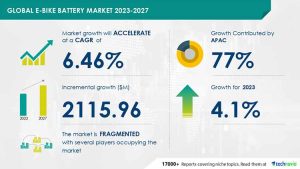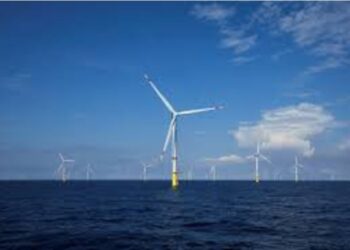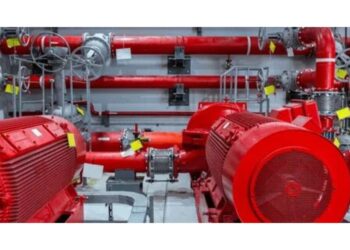The E-bike battery market size is estimated to grow at a CAGR of 6.46% between 2022 and 2027. The market size is forecast to increase by USD 2,115.96 million. APAC is estimated to contribute 77% to the growth of the global market during the forecast period. China, Vietnam, Japan, and India are some of the major markets for E-bike batteries in the APAC region. Of these, China is the largest contributor to the e-bike battery market in the region. Furthermore, the E-bike battery market in the rest of APAC is growing at a remarkable rate. Due to the rising disposable income and urbanization, the demand for electric bicycles in India, Vietnam, Malaysia, and Singapore is expected to increase in the future. Therefore, these factors and rapid growth will boost the growth of the market in this region during the forecast period.

Company Landscape
The e-bike battery market is fragmented; the companies are competing with competitors and are trying to get a greater market share. The market is growing, and the chances of new entrants cannot be overlooked. The major companies have well-established economies of scale and market presence and generally rely on positioning technological advances, and the price of the products –The report provides a full list of key companies , their strategies, and the latest developments.
Market Dynamics
Key Driver
The longer shelf life of Li-ion batteries when compared with other battery technologies is the key driver for the growth of the e-bike battery market.
Leading trend –
Advances in E-bike designs are the primary trend in the market.
Significant challenge –
Lead pollution and stringent laws are a challenge that affects the growth of the market. Recycling lead-acid batteries results in fewer disposable batteries being disposed of as solid waste. Recycling lead-acid batteries in densely populated areas with limited pollution control measures has a significant environmental impact. Furthermore, the demand for lead-acid batteries has increased due to the wider range of battery energy storage applications in hybrid electric vehicles and renewable energy production. However, the production of lead-acid batteries comes with many environmental risks, mainly lead pollution. Hence, these factors are expected to impede the growth of the market during the forecast period.
Company Profiles
The e-bike battery market report includes information on the product launches, sustainability, and prospects of leading companies including BMZ Holding GmbH, Coslight India Telecom Pvt. Ltd., Giant Manufacturing Co. Ltd., GRUPO FOTONA, Guangzhou Yuntong Lithium Battery Co. Ltd., Hunan CTS Technology Co. Ltd., Johnson Matthey Plc, Kingbo Power Technology Co. Ltd., LG Corp., Melsen Power Technology Co. Ltd., OptimumNano Energy Co. Ltd., Panasonic Holdings Corp., Phylion Battery Co. Ltd., Robert Bosch GmbH, Samsung Electronics Co. Ltd., Shenzhen Handpack Technology Co. Ltd., SHIMANO INC., VARTA AG, Yamaha Motor Co. Ltd., and ZHANGZHOU YOKU ENERGY TECHNOLOGY Co. Ltd.
Competitive Analysis
The report includes competitive analysis, a proprietary tool to analyze and evaluate the position of companies based on their industry position score and market performance score. The competitive scenario categorizes companies based on various performance indicators. Some of the factors considered include the financial performance of companies over the past few years, growth strategies, product innovations, new product launches, investments, and growth in market share, among others.
Market Segmentation
The E-bike battery market report extensively covers market segmentation by distribution channel (offline and online), type (lead acid battery, Li-ion battery, and nickel-metal hydride (NIMH) battery), and geography (APAC, Europe, North America, South America, and Middle East and Africa).
The offline segment is estimated to witness significant growth during the forecast period. Offline sales channel includes department stores, hypermarkets, and warehouses. Factors such as customer segmentation, ease of production and inventory management, and transportation of merchandise are largely dependent on suppliers with an organized retail base. Offline stores display a wide range of products from different brands and categories, thus allowing consumers to choose products according to their needs and budget. In developing countries, such as China and India, brick-and-mortar retail stores are still considered as the most reliable choice for purchasing E-bike battery products. As a result, the demand for E-bike batteries from offline channels is increasing, which will drive the growth of the market during the forecast period.













